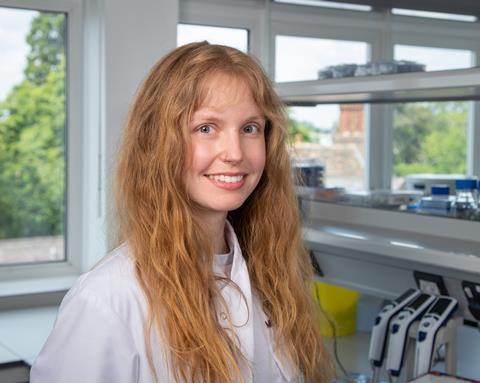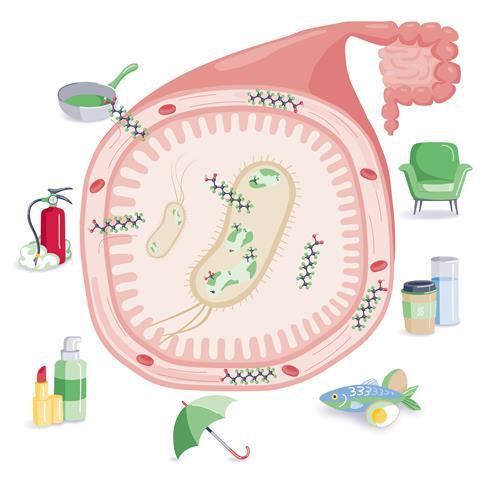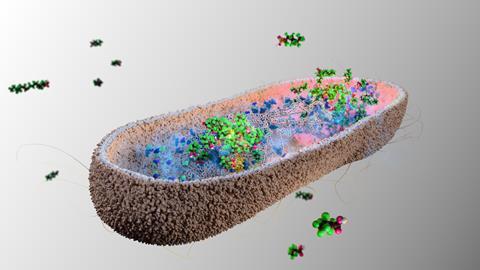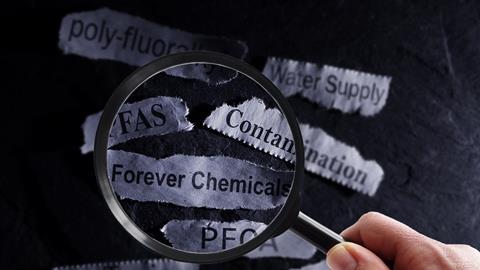Anna Lindell had a slow start to her PhD, but it was worth the wait. She started in 2020 and across Cambridge University; laboratories, lecture halls, and libraries were closed. For Anna, this posed a problem. Her equipment orders were delayed, and she couldn’t go into the lab to run experiments and get the much-needed data for her PhD.
Anna was studying in Kiran Patil’s lab at the MRC Toxicology Unit whose focus is on the gut microbiome. This is the community of bacteria and other microorganisms that live in our intestine. These tiny helpers digest our food, educate our immune system and make it harder for disease causing microorganisms to grow. Kiran’s research looks at how chemicals in the environment affect the bacteria inside our gut. We are constantly exposed to things in our environment from the medicines we take and contaminants in the food we eat, to particles in the air we breathe. Figuring out which chemicals are harmful and how they affect us, is essential to make our surroundings safer.

With plenty of time out of the lab, Anna and Kiran decided to find out all they could about how man-made chemicals alter our gut microbiome. Reading scientific papers on these non-biological compounds, known as xenobiotics, they realised that there was a lot that we didn’t know. “There was a lot of information out there on gut bacteria and drug or nutrient interactions, but there was really very little looking systematically at gut bacteria and pollutant interactions” Anna explains. “All sorts of compounds that are common environmental pollutants have been shown to also be found in food. So we thought that would be reasonable to assume that they also interact with our gut bacteria.”
Once they were back in the lab, Anna and Kiran knew what they had to do. They took 42 common pollutants, those present in pesticides, materials contacting food, and industrial chemicals; and combined them with bacterial species that are found in healthy people. Whilst the bacteria interact with around a quarter of the pollutants, two chemicals called perfluorooctanoic acid (PFOA) and perfluorononanoic acid (PFNA) stood out. Why? Because not only could the bacteria reduce the amount of these chemicals in their surroundings by as much as 75%, but because these were part of a group of chemicals called PFAS. Short for per- and poly-fluoroalkyl substances (PFAS), these chemicals are used in wide range of common products such as ski wax, outdoor textiles, carpets and fire-fighting foams. Notoriously difficult to destroy, they have been nicknamed ‘forever chemicals’ and are widespread in the air, soil and water systems.

This finding directed the course of the rest of Anna’s PhD. As Anna describes “The reason that we ended up working on PFAS was like so many things in science, a bit of chance. We were doing broad screens of many different chemicals such as pesticides, nitrosamines, and bisphenols” says Anna. “But in the initial results we saw that some of the PFAS we’d added were accumulated to quite high amounts by several types of bacteria. We thought that this was really interesting because PFAS are such a big problem.” As these forever chemicals have been linked with cardiovascular disease, cancer, and developmental disorders, this finding presents a potential solution. Kiran adds “We were quite surprised because no one had reported PFAS accumulation by human gut bacteria before. This was important, given the scale of the problem for PFAS and that very little is being done about it, especially in the health context”.
Understanding the health effects of PFAS
PFAS are a group of nearly 15,000 chemicals that are heat resistant with water and grease repelling properties. One of the first and best known PFAS types is polytetrafluoroethylene (PTFE), commercialised under the name Teflon and used to make non-stick pans. Initially, PFAS were thought to be harmless so there were no restrictions on their use. “In the past it was thought that PFAS couldn’t interact with biological molecules” says Patil “This was also the reason why PFAS were thought to be safe, they were inert, unlike other toxic compounds that react with molecules in our cells. Of course, it is often the way that an assumption stands because no-one is testing if it is true”.
The dangers of PFAS are in their longevity. Because they are so tough, these forever chemicals stick around and accumulate not just in our environment, but in our bodies. We are mainly exposed to PFAS through our food and in contaminated drinking water. PFAS that we ingest are taken up in our stomach and intestine and travel into the blood stream. As our bodies can’t break them down, they circulate in our blood stream until they are passed out in our urine and faeces. Kiran explains the problem, “Whilst short chain PFAS molecules are removed in a matter of days, longer more ‘sticky’ PFAS can hang around for years inside the body, building up in the liver, kidneys and other organs.”
Unfortunately, PFAS are present in most of us. According to the Centre for Disease Control (CDC), 98% of American adults have detectable levels of PFAS in their blood. PFAS can also pass to the next generation in breast milk. But not everyone is affected to the same extent. In a study of nearly 2000 European teenagers, 14% had higher PFAS level than current guidelines. We still don’t know why some people are more affected than others, although some have suggested that it is associated with differences in diet.
We are still figuring out what the safe level is for PFAS. The European Protection Agency found in 2022 that forever chemicals could cause harm at levels much lower than previously understood. Although PFAS have been around for more than 80 years, we still don’t know enough about how they interact with our cells. PFAS are hard to study because it takes decades of being exposed to see the health effects. Anna explains “I think of it a bit like smoking. Smoking a cigarette isn’t going to kill you, but if you smoke for decades then your life could be shortened by about 10 years. It’s similar with PFAS. Having a high PFAS exposure in the moment doesn’t make you feel any different. But if you have a high exposure over your life, you might end up getting one of these diseases.”
So how dangerous are PFAS really? Prof. Tina Kold Jensen, PFAS epidemiologist at the Institute of Public Health, University of Southern Denmark explains “The increased risk of disease from PFAS exposure is small on an individual level, often on the order of 10 additional cases per 100 people. For a relatively rare disease like kidney cancer, that still means your personal risk remains low. But the real concern is broader. PFAS exposure is involuntary and affects virtually everyone. So even a modest increase in risk of say 10% becomes significant when it’s applied across the entire population. In public health terms, that can translate to a large number of people affected.”
Removing PFAS from the environment
The contamination of our environment by forever chemicals is extensive. As Anna explains “Across Europe and the US, there’s more than 70,000 known contamination sites, and there’s probably many more that we don’t know of”. For example, the Forever Pollution Project identified that there is much more contamination in Europe than previously thought. As new information comes out about PFAS, government policies are being reviewed and updated. Last year, the US Environmental Protection Agency updated the allowed limits of six common PFAS in drinking water, whilst lower permitted levels will come into effect in European countries in 2026.

Meeting these new requirements is a multi-billion-dollar problem. Sorbents, such as Granular Activated Carbon (GAC), are used to trap and remove PFAS from drinking water on a massive scale. One example is at the water treatment plant in Wilmington in North Carolina which recently underwent a 43-million-dollar expansion to remove PFAS from the Cape Fear River and provide clean drinking water. Once contained, the challenge is then how to destroy the forever chemicals. GAC filters are often burned or reactivated but this can break up the PFAS into smaller molecules that are released into the air. A plethora of academic projects and start-ups have been created to find more effective ways to destroy PFAS. One research team at Oxford Brooks University found that bubbles created by changes in pressure can break apart the PFAS molecule. Excitingly, this approach doesn’t require an electricity supply or the addition of any chemicals, meaning that it could be used in less developed countries.
Removing PFAS from the body
As we tackle the problem of PFAS in the environment, it remains an open question of how to deal with the PFAS already present in our bodies. In the 1990s, PFAS were present in the water-based foam used at a firefighting training ground in Jersey Island. It took decades for the residents and authorities to realise that it had leaked into the ground and contaminated water supplies. Measurement of Jersey islanders in 2022 found that they had elevated levels of PFAS in their blood. In a revival of a 3000-year-old treatment, scientists recommended letting out the patient’s blood and replacing it with donated blood. This treatment was used for exposed individuals in Canada, Australia and Italy resulting in a modest 1-8% reduction. As this procedure involves using donated blood, the treated person will only benefit if their PFAS level is significantly above average.
Long PFAS molecules can bind to bile acid transporters which carry bile acids from the liver to the gut, allowing the PFAS to re-enter the blood stream. This allows PFAS to circulate in our bodies for years, accumulating in essential organs. Another treatment that is being tested in clinical trials specifically targets this ability of PFAS to hitchhike onto bile acids. It involves Anion Exchange Inhibitors (AER), drugs that have been approved to treat high cholesterol in the blood. AERs bind to bile acids, creating a complex that can’t be absorbed into the blood stream. In a small study, 12 weeks of AER treatment reduced PFAS in the blood by 60%. However, there were some side effects such as constipation, diarrhoea and abdominal pain. Whilst these may be accepted in highly exposed individuals, these would not provide a long-term solution for people exposed to low levels of PFAS.
Using gut bacteria to remove PFAS
As there are currently very few methods for removing PFAS from our body, Kiran and Anna’s finding that certain species of bacteria present in our gut can take up and store PFAS, provides hope for an effective treatment with no side-effects. They showed that bacterial species such Bacteroides could do this even if there was a very small or very large amount of PFAS. Prof. Marie Joossens, expert on microbial ecosystems and their health effects at Ghent University, explains the importance of these findings “Waste and harmful substances can be eliminated from our bodies via stool. While this is well known for our own body’s chemicals, the discovery that this may also serve as an exit route for persistent pollutants like PFAS is exciting. Notably, the finding that certain gut bacteria can capture these forever chemicals fast and retain them on their way out of the human body, opens up new possibilities for mitigating the serious health risks associated with PFAS exposure.”

This is not the first time that bacteria have been found to interact with PFAS. Other studies have found that bacteria in soil and wetland ecosystems can bind to PFAS. Kiran explains why this study is different, “The capacity that has been reported for soil bacteria is orders of magnitude lower than what we see” says Patil “The gut bacteria seem to have a remarkably high capacity to soak up these compounds from the environment.”
Some studies had found that PFAS could bind to bacterial membranes, but no-one had shown before that PFAS could go inside bacteria. Working with the MRC Laboratory of Molecular Biology, the researchers used a technique called FIB-SIMs which uses a laser to scan and then remove nanometer thin sections of a frozen bacterium to build up a detailed picture of the fluorine atoms present in PFAS. Amazingly they saw that the PFAS molecules had clumped together into in a few pockets inside the bacteria. The researchers think that this condensing of PFAS is why the bacteria could still function with so much PFAS inside them. Accumulating PFAS didn’t affect the bacteria’s growth or the production of metabolites, molecules produced from chemical reactions inside the bacteria. This is good news as the health of our gut microbiome is closely linked to our overall health.
What can we do next?
So how can we use these tiny helpers to solve our PFAS problem? As certain types of bacteria seem to be better than others, we might be able to send in those species to mop up the PFAS. Think of it like a miniature SWAT team, sent in to clear up the PFAS and then get out of there. From a rather unexciting start of her PhD spent reading scientific papers, Anna is now part of the start-up Cambiotics. Working with the other co-founders Peter Holme Jensen and Kiran Patil, they are creating probiotic supplements that target these forever chemicals. Anna explains “We are working to take the finding from the lab that gut bacteria can accumulate PFAS and turn into a product that can help detoxify the body from PFAS. We’re taking highly accumulating bacteria and putting them into a capsule format that you can take.” This treatment will need to be tested in humans first, but in the meantime, we can prevent some PFAS from entering our bodies. Water filters are a simple but effective way to trap PFAS before it enters our body. We can also avoid PFAS containing products such as waterproofing, ski wax and non-stick pans. Although we can’t remove all forever chemicals from our surroundings, there is hope that in the future we will have safe and effective treatments to help us defend our bodies from PFAS.
Additional information
PFAS Exposure and Health Effects
The Map of Forever Pollution (Europe)
How to get rid of toxic ‘forever chemical’ pollution
Using bubbles to remove forever chemicals from our water
Møller, J., Lyngberg, A. C., Hammer, P.E.C., et al. Substantial decrease of PFAS with anion exchange resin treatment – A clinical cross-over trial. Envir Int. 185. (2024) 108497
Conflict of interest
Rachel works for the MRC Toxicology Unit where the authors of the study “Human gut bacteria bioaccumulate per- and polyfluoroalkyl substances” are based.








No comments yet